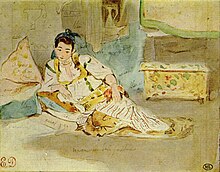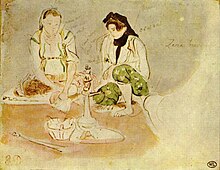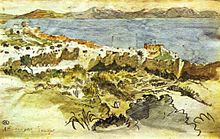The women of Algiers
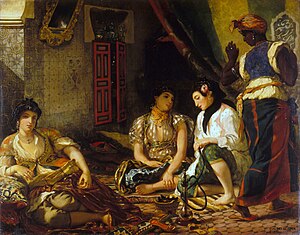
|
| The women of Algiers |
|---|
| Eugène Delacroix , 1834 |
| Oil on canvas |
| 180 × 229 cm |
| Louvre, Paris |
The women of Algiers (also: The women of Algiers in their chamber , French Femmes d'Alger dans leur appartement ) is a painting by the French painter Eugène Delacroix (1798–1863). The 180 × 229 cm picture was created in 1834 and was first presented at the salon , where it was unanimously admired. King Louis-Philippe I bought it and donated it to the Musée du Luxembourg , then a museum for contemporary art. After the artist's death, it was moved to the Louvre in 1874 .
The picture stimulates the imagination with sexual innuendos; it shows Algerian concubines in a harem . In the 19th century it was very well known for this and for its orientalism . The painting was a source of inspiration for the later Impressionists and in 1954 inspired Pablo Picasso to create a series of 15 paintings and numerous drawings, Les femmes d'Alger . The most famous painting from the series is version "O" .
history
In 1830 France had begun to conquer Algeria; At the end of 1831 the young diplomat Charles de Mornay was commissioned with a trip to the Sultan of Morocco . At that time it was common to take artists with you to capture such a trip in pictures. Mornay was friends with an actress who suggested her friend Delacroix for the job. The invasion and occupation of Algiers had very profane reasons; the French government owed a large sum to an Algerian merchant, and the Turkish governor insisted on payment. On the occasion of an audience, he let himself be carried away to hit the French ambassador with a fly swatter, which the French government used as a pretext for the occupation of the country. The border to Morocco was difficult to control, so that diplomatic cooperation with the Sultan of Morocco was sought. Although the mission was a success, the Sultan did not take the treaty very seriously. Finally, France also attacked Morocco to assert its interests.
In contrast to the head of the mission, who missed Parisian life and found this area and its people simply barbaric, the painter enjoyed the atmosphere, the colors, the objects, the people, the architecture in this strange world. After all, Delacroix noted in his diary that although he was surrounded by beauty in North Africa, there was a lot of trouble with regard to human rights and equal treatment before the law. Since Islam forbids all images and women were veiled in public, it was difficult for Delacroix to get pictures of women; men predominate in his sketchbooks. When he tried to remotely sketch some women hanging laundry on the roof terrace, they immediately alerted their husbands. He was only allowed into one Jewish household; therefore he could later paint the Jewish Wedding and The Jewish Bride .
So he had no luck in Morocco. He made his sketches for this painting at the last moment in Algiers, then firmly in French hands, where he stayed for a few days on the return journey. A former Christian who converted to Islam and collaborated with the French is said to have given him access to his harem.
“After you have gone down a gloomy corridor, you enter the part of the house that is reserved for women. The eye is literally blinded by the bright light, the fresh faces of the women and children in the midst of a lot of silk and gold. For a painter this is the moment of fascination and a strange feeling of happiness. "
The harem
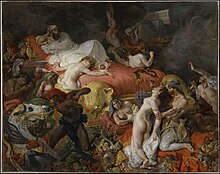
Harem scenes in paintings and books were quite popular in his day. Orientalism reached its first climax during the siege of Egypt by Napoleon in 1798, the year Delacroix was born. Another high point was France's enthusiasm for the Greek cause in the Greco-Turkish War of 1821/30, about which Victor Hugo wrote the volume of poetry Les Orientales ; Delacroix contributed two paintings: The Chios Massacre (1824) and La Grèce sur les ruines de Missolonghi (Greece dying on the ruins of Missolonghi) (1826), a forerunner of his most famous painting Freedom Leading the People , 1830.
For European men, the harem was a kind of elegant private brothel ; This painting has a not inconsiderable part in this idea, although it did not invent it. The problem with European artists was that no one could get access to a harem. The fantasies were obviously pure inventions and therefore hardly credible (see for example Jean-Léon Gérôme : Une piscine dans le harem. A harem bath , 1876). On the other hand, Delacroix could refer to the appearance; that was what gave his work a special weight, credibility and authority.
Nevertheless, this painting in no way reflects reality, but rather presents a mixture of this and common European conventions. The women - with the exception of the black slave who seems to be leaving the room - are all lying or sitting around in a very obvious way. In reality, however, the harem was teeming with children and activities of all kinds - the women were by no means alone and inactive, patiently awaiting the approach and engagement of their master. This is all the more surprising as Delacroix himself noted in his diary that children could not be overlooked. The natural family situation thus becomes the contact room of a brothel, as it was presumably to be found many times in Paris.
Wealth, power, sex
So Delacroix did not reproduce reality as he could demonstrably see it, but also his own imagination, supported by observations. So he used sketches that he could make on site, but decorated them as desired. The women are also obviously white women; the one on the right, who bears a certain resemblance to the person sketched on site, is known to be a Parisian model and a longtime friend of Delacroix. White women as slaves in Islamic harems have also long fired the European imagination, right up to the highly successful series of novels Angélique , filmed in 1968 as Angélique and the Sultan , in which the Arab ruler was usually depicted in a very dark and gloomy manner.
The women are presented as objects of pleasure, more or less willing, at the mercy of the almighty owner and waiting to be allowed or to be of service to him. In view of the repressive sexual morality of the 19th and 20th centuries, this fantasy, which Islam seems to legalize, seems quite understandable and comprehensible; to this day it is often projected onto oriental conditions and, for example, portrayed in historical films with or without documentary character.
Of course, a harem is also associated with wealth; a surplus of women on the one hand has to be bought at the cost of a shortage of women on the other. Wealth is connected with power, and the rich and powerful have always been allowed to maintain as many partners as they want and to produce as many offspring as desired with them, also in the West; see for our culture area Charlemagne: marriages and descendants and concealment . Due to this fact, the image of the harem also lends itself to a projection surface for power and wealth and thus for the three greatest driving forces at least for male humanity.
Delacroix had already formulated his fantasy of wealth, power and luxury including sexual pleasure in the oversized painting The Death of Sardanapal in 1827 before his trip to North Africa ; Shortly before his end, which he himself wants to bring about with poison, the ruler delights himself in the systematic slaughter of his favorite creatures, including horses and, above all, beautiful women. To this day, however, this fantasy has not found much resonance with the audience; this picture probably lacks the promise of enjoyment.
The exotic
The depiction of the harem also serves the longing for the exotic, which was rampant in the 19th century and, for example, drove Paul Gauguin to Tahiti . The German romantic painters instead orientated themselves in the past ( Karl Friedrich Schinkel , Caspar David Friedrich ), emigrated to Rome and even wanted to screw back into the Middle Ages like the English Pre-Raphaelites ( Nazarenes ), while French painting made its way through the colonial conquests of France encouraged to praise the fatherland. Even the neo-classical painters of France and precisely these produced odalisques who have not lost their effectiveness and fascination to this day, especially Jean-Auguste-Dominique Ingres .
This subject was immediately taken up by the Impressionists, even though it was not about outdoor painting. From there, it made its way into modern art and into the 20th century: the odalisques of Matisse and Picasso were painted before and after the Second World War and even left their mark on Pop Art . One of Matisse's main works, Luxe, Calme et Volupté , to a certain extent transfers the topic to the open air and merges it with the longing for the land of milk and honey .
Influence on Cézanne
For Paul Cézanne , who is known to be of paramount importance for Cubism and thus for all of modern painting, this picture was a revelation that carried him to cheers:
“For the Impressionists, Delacroix was both an inspiration and a forerunner. Delacroix was an idol for Cézanne, who copied The Women of Algiers in Her Chamber and The Dante Barque ; The dark analogy of Die Barke left its mark on all of Cézanne's work. [...] His praise for women from Algiers in their room sounds like poetry: "We are all part of this Delacroix. When I talk about the joy of color for the sake of color, that's what I mean ... These pale roses , those shaggy horses, those Turkish slippers, all this transparency, I don't know, they penetrate your eyes as if a glass of wine were running down your throat and you are tipsy immediately. You don't know how, but you feel lighter ... Things start to spin around you. It is the first time since the times of the great masters that bodies have been painted like this. And with Delacroix there is something else, a fever that does not exist with the masters.… What always people say or act, he is part of the great development. You can talk about them without blushing, even after Tintoretto and Rubens . ... Delacroix is romantic, maybe. He ate himself up with Shakespeare and Dante, it was Excessiveness, he turned the pages too often in the fist . But it still has the most beautiful palette in all of France, nobody else in this country has mastered the calm and the movement at the same time, the vibrations of color. We all paint in its shadow. ""
Typically, Cézanne completely disregards the content of the painting, which, however, cannot be separated from the formalities and even make up the essential aspect of the painting. The colors and shapes that made Cézanne drunk trigger very specific feelings that are inextricably linked with the objects in the picture.
Influence on 19th century painting
In Delacroix's successor, Auguste Renoir and Henri Matisse traveled to North Africa, as did August Macke and Paul Klee , to experience the light there. For the German painters of the 19th century, however, Delacroix did not have the same meaning as in France in relation to light.
“If there is one constant within 19th century oriental painting, it is the view that the orient and light are inextricably linked. Since Delacroix, the Orient attracted painters because of the peculiarities of the prevailing light conditions and their effect on the colors. Even before the breakthrough of Impressionism, it was the French orientalists who brought dazzling light into the chiaroscuro painting of the salon. During his trip to Morocco, Delacroix observed light effects, reflections and shadows very closely and developed his color theory during this time in North Africa. "
German Impressionism (for example Max Liebermann , Max Slevogt ) lacks the overwhelming effect of light, which of course is hardly possible in Germany, so that August Macke and Paul Klee were only able to experience it in North Africa. Macke and Klee no longer have anything to do with the open-air painting of Impressionism; Exotic and sultry erotic are also alien to them.
The particular fascination of this painting, however, does not lie in the lighting conditions, as it is an interior space, or the colors, as beautiful as they are, but in the subject. The women of Algiers , the erotic fascination of the harem, the exotic exaggeration of the subject of the compliant, dependent woman developed their effects in French painting, but found no resonance in German painting. Just like the German painters of the 19th century, who originally came from battle painting ( Otto von Faber du Faur , Adolf Schreyer ), did not understand the oriental battle painting of the French because Germany had no colonies and towards the middle of the century had no colonial intentions, so the tradition of odalisque painting, which had long existed in France and still celebrated true triumphs with Matisse and Picasso, found no imitators in Germany (and the rest of the world). The subject has remained a French subject.
criticism
Delacroix has also given himself a lot of freedom in decorating the room. It would be inconceivable to have Arabic characters hanging on the wall as decoration; For Delacroix, however, the mostly invented characters were a cheap means of selling exotic items to his Parisian audience. The success of the painting is therefore based entirely on a deception: It claims an authenticity that it cannot deliver.
The water pipe, however, actually corresponds to the customs and is worth a closer examination. Through its association with opium and prostitution , this detail takes on a significance that Delacroix was probably not intended. Towards the end of the 19th century, people turned away from the euphemistic romanticization of prostitution and looked at reality, which presented itself as extremely ugly. But critical elements can also be seen in the harem paintings and odalisques.
Women are not only portrayed as objects of lustful men, but also as beings of their own right and dignity. In doing so, they are not only portrayed passively, but even apathetically, they quietly fit into their fate, and that throughout Delacroix, his predecessors and successors, because that is part of the essence of the harem or odalisque theme in European painting; This passivity and quiet resignation can be traced back to the Renaissance, where it appears in Tizian and Giorgione in the theme of Venus or nymph or lover of a god, which also has to be a kind of odalisque, namely by submitting to the wishes of the god must: she has no choice.
As beautiful as these women are, as calm and cozy as the atmosphere is, it is noticeable that the water pipe plays a very central role. She not only emphasizes her position directly in front of the group of the two women on the right, the striking drapery of the slippers and the basket, the extension of the water pipe in the white arm of the middle woman, the path taken by the servant, which seems to come straight from the water pipe , the woman on the right even holds the mouthpiece in her hand - the pipe is being used.
The woman on the left naturally takes on a special role due to her isolation and placement on the left edge of the picture; In contrast to the other two women, who appear to be much more lively, she seems to be downright sleepy, possibly due to the previous use of the pipe. For where someone cannot escape his fate, he may escape reality with the help of drugs, perhaps opium. Opium was easy to get; the British kingdom had waged two opium wars against China in the mid-19th century in order to be able to do business with it there unhindered.
If you look more closely, these pictures also contain a very delicate accusation. Strictly speaking, the “attitude” of women in a harem deprives them of their rights as human beings, which makes their passivity and resignation appear credible; in this respect, her position is on the one hand more comfortable and honorable than that of a prostitute, but on the other hand it is more hopeless, since she can preserve at least part of her dignity and rights. The French impressionists in particular like to portray prostitutes ( Henri de Toulouse-Lautrec , Edgar Degas ) as resolute personalities who, if necessary, can defend themselves against their suitors and may even take this freedom out of their hands.
The object character of women, which in the 19th century was considered more or less natural by European men, was only made a subject of discussion towards the end of the 19th century by the emerging women's movement and then 100 years later by feminism . The artists had no part in this upheaval. Delacroix himself was evidently amenable to the charms of women, but nonetheless remained a bachelor his entire life. Only in the year this picture was created did he get himself a housekeeper who corresponded to his ideas of availability and non-interference in his personal life; He apparently saw this realized in his picture of the women of Algiers , because he is said to have said: “This is my idea of a woman!”.
literature
- Eugene Delacroix: Journal de Eugene Delacroix… precede d'une etude sur le maitre par M. Paul Flat; notes et eclaircissements par MM. Paul Flat et Rene Piot… E. Plon, Nourrit et cie., Paris 1893. (Various formats) Retrieved 23 August 2012
- Eugene Delacroix, Gilles Néret: Eugene Delacroix, 1798–1863: The Prince of Romanticism (Basic Art). Taschen, Cologne 2000, ISBN 978-3-8228-5988-9
- Rose-Marie Hagen, Rainer Hagen: What great paintings say, Volume 2. Taschen Verlag, Cologne 2002, ISBN 978-3-8228-1372-0 . Google Books. Retrieved September 13, 2010
Web links
Individual evidence
- ↑ a b Hagen, p. 361
-
^ Elizabeth Cowling: Picasso Challenging the Past (National Gallery Company). Yale University Press, New Haven 2010, ISBN 978-1-85709-451-0 , pp. 109-114
· Rachel Campbell-Johnston: Picasso: Challenging the Past, National Gallery, London WC2 In: The Sunday Times , February 2, 2009 , accessed September 9, 2010
· Karl Kreuzer: Picasso and the Masters. Report on a short trip to Paris with pictures from the exhibition, including variations from Picasso to Delacroix. Retrieved September 9, 2010
· On-Line Picasso Project : Un matin au harem. ( Page no longer available , search in web archives ) Info: The link was automatically marked as defective. Please check the link according to the instructions and then remove this notice. OPP.54: 270. Cannes September 8/1954, Color crayons & gouache on paper, 50 × 64 cm. Collection: Sotheby's. Retrieved September 13, 2010 - ^ Page from the Moroccan notebook 1832, watercolor, 19 × 13 cm. Musée du Louvre, Department des Arts graphiques, Paris. Retrieved September 13, 2010
- ↑ a b c d e f g Hagen, p. 358
- ↑ Hagen, p. 360
- ↑ The Jew's Bride. 1832, watercolor, 29 × 24 cm, Musée du Louvre, Paris
- ↑ Having walked down some dingy corridor, you enter the part of the house which is reserved for [the women]. The eye is truly dazzled by the bright light, the fresh faces of the women and children amidst a mass of silk and gold. For a painter, it is a moment of fascination and strange happiness.
-
↑ La Grèce sur les ruines de Missolonghi (Greece dying on the ruins of Missolonghi). 1826, oil on canvas, 208 x 147 cm, Musée des Beaux-Arts, Bordeaux
· Messolongi: Eugène Delacroix as Philhellene - ^ Jean-Léon Gérôme: Une piscine dans le harem. (A harem bath). 1876, oil on canvas, 74 × 62 cm. Hermitage , St. Petersburg
- ↑ Hagen, p. 363
-
↑ Jean-Auguste-Dominique Ingres:
· La Baigneuse dite Baigneuse de Valpinçon , 1808. Oil on canvas, 146 × 98 cm. Louvre.
· Grande Odalisque , 1814. Oil on canvas, 89 × 163 cm. Louvre.
· Odalisque with slave girl. 1842, Walters Art Museum, Baltimore. Oil on canvas, 76 × 105 cm
· Le Bain turc , 1862. Oil on canvas, 108 × 110 cm. Louvre. - ^ Pierre-Auguste Renoir: Odalisque. 1870, oil on canvas, 69.2 × 122.6 cm. National Gallery of Art, Washington DC
-
↑ Henri Matisse: (Accessed September 13, 2010)
· Odalisque with a green plant and Screen. 1923, 61 × 50 cm. Statens Museum for Kunst, Copenhagen
· The Hindu Pose. 1923, 83 × 60 cm. Private Collection
· Moorish Woman with upheld Arms 1923 65 x 50 cm. Washington Gallery of Art, Washington, DC
· Odalisque. 1923, 61 × 74 cm. Stedelijk Museum, Museums Dienst voor Moderne Kunst, Amsterdam
· Odalisque with Magnolia. 1923-1924, 65 × 81 cm. Private Collection
· Odalisque with a Tambourine. 1925-1926, 74.3 x 55.7 cm. The Museum of Modern Art, New York
· Odalisque. 1926, 73 × 60 cm. Metropolitan Museum of Art, New York
· Odalisque. 1926, 73 × 60 cm. Metropolitan Museum of Art in New York
· Figure on to ornamental. 1934, 131 × 98 cm. Musée National d'Art Moderne, Center George Pompidou, Paris -
↑ On-Line Picasso Project : (Accessed September 13, 2010)
· Nu, étude pour le harem. ( Page no longer available , search in web archives ) Info: The link was automatically marked as defective. Please check the link according to the instructions and then remove this notice. OPP.06: 037. Gósol, [Spring ~ Summer] 15-May ~ 15-August / 1906, watercolor on paper, 64.1 × 49 cm. The Cleveland Museum of Art · Le harem (Nus roses). ( Page no longer available , search in web archives ) Info: The link was automatically marked as defective. Please check the link according to the instructions and then remove this notice. OPP.06: 038. Gósol, Early-Summer / 1906, Oil on canvas, 154.2 × 110 cm. The Cleveland Museum of Art
- ↑ Paul Wunderlich : Dream of an Odalisque. ( Memento of the original from September 26, 2016 in the Internet Archive ) Info: The archive link was inserted automatically and has not yet been checked. Please check the original and archive link according to the instructions and then remove this notice. 1975, original lithograph in 9 colors, signed in pencil by the artist. Retrieved September 13, 2010
- ^ Henri Matisse: Luxe, calme et volupté. 1904-05, oil on canvas, 99 × 118 cm, Musee d'Orsay, Paris
- ↑ Eugène Delacroix: La Barque de Dante. 1822, oil on linen, 189 × 241 cm
- ↑ Eugene Delacroix, Gilles Néret, page 26: "For the Impressionists, Delacroix what Both of inspiration and a forerunner. For Cézanne, who copied the Women of Algiers in their apartment (p. 53) and The Barque , Delacroix was an idol; the sombre analogy of [The Barque] left its mark on Cézanne's entire corpus. [...] His praise of Women of Algiers in their apartment attains to poetry: "We all have our place in this Delacroix. When I talk about the joy of color for color's sake, that's what I mean ... These pale roses, these shaggy steeds , this Turkish slipper, all this limpidity, I don't know, they go in at the eyes like a glass of wine going down the throat, and immediately, you're drunk on it. You don't know how, but you feel lighter… Things start to spin round one. It's the first time volumes have been painted since the Masters. And in Delacroix, there is something else, a fever, which isn't there in the masters.… Yes, whatever people say or do, he's part of the great line. You can talk of them, without blushing, even after Tintoretto and Rubens.… Delacroix is Romanticism, perhaps. He gorged himself with Shakespeare and Dante, it was overindulgence, he leafed through Faust too often. But he still has the most beautiful palette in France, no one else in this country has managed the calm and th e moving at the same time, the vibration of color. We all paint in his shadow. "«
- ^ Karin Rhein: German Orientmalerei in the second half of the 19th century. Tenea Verlag, Berlin 2004, ISBN 978-3-86504-035-0
- ^ History of the World: The Harem. ( Memento of September 16, 2010 in the Internet Archive ) Retrieved September 13, 2010.
- ↑ Chinese Prostitute Smoking Opium: San Francisco circa 1890 . ( Page no longer available , search in web archives ) Info: The link was automatically marked as defective. Please check the link according to the instructions and then remove this notice. Opium Museum. Retrieved September 13, 2010
-
↑ National Maritime Museum , London: (Accessed September 13, 2010)
· Prostitution in maritime London. 19th-century responses to prostitution. There is also a description of a woman's fate in connection with prostitution, alcohol and opium.
· Opium smokers. Photo, anonymous, ca.1890 - ↑ Titian (Tiziano Vecellio): Venus of Urbino 1566
- ↑ Lucas Cranach the Elder : Resting spring nymph. c. 1550, oil on panel, 77 × 122 cm, Thyssen-Bornemisza Collection, Madrid
- ↑ On the history of opiates . ginko Foundation for Prevention, accessed September 13, 2010.
- ↑ Even Gauguin's exotic descriptions do not see women any differently, not to mention how he treats them.
